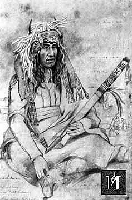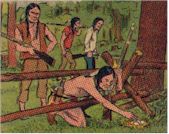



(c) Minnesota Historical Society
![]()
Cartoon History of the Sioux Uprising of 1862
Dakota
Conflict of 1862 - Student Page
Introduction | The Task | The Process | Evaluation | Conclusion | Credits
Welcome to an interactive U.S. History / Social Studies experience designed for sixth, seventh, and eighth grade students. This webquest was made for further inquiry / investigations of the American Indians, the Dakota, and specifically the Dakota Conflict of 1862 (aka, the Sioux Uprising of 1862).
You are a 'newspaper reporter' for the St. Paul Pioneer Dispatch, located in St. Paul, Minnesota. Read the question below, then move on to 'the task'.
A question to start your engines, 'What else happened in our U.S. History during the time of the Civil War in Minnesota?'
It is January
1, 1863, and the Sioux Uprising ![]() hangings happened about a week ago. You are newspaper reporters working
for the finest paper in your state, the St. Paul Pioneer Dispatch. The
publisher of your newspaper has called a meeting with the newspaper staff.
He said, “We do not want people to forget what has happened during
the past twelve years. We must record the truth as we know it about the
Dakota Wars and what led up to it so that others will remember.”
hangings happened about a week ago. You are newspaper reporters working
for the finest paper in your state, the St. Paul Pioneer Dispatch. The
publisher of your newspaper has called a meeting with the newspaper staff.
He said, “We do not want people to forget what has happened during
the past twelve years. We must record the truth as we know it about the
Dakota Wars and what led up to it so that others will remember.”
The end result of this webquest will be:
- a newspaper article made on broadsheet, tag board for classroom display;
- a word processed article template using Word 2000;
- a word processed article utilizing Notepad, Simpletext, or others;
- a PowerPoint 2000 presentation, use this 'War News' Notebook;
- or, if you are really motivated, make a webpage!
You may use encyclopedias, library resources, and any other material you can find, and more immediate, the Internet. And make sure you have the minimum below:
- Internet Explorer 5.5 and above; Netscape Communicator 6 and above; Microsoft Word 2000 (PC or MAC); Notepad (PC); Simpletext (MAC)
- One Internet connected PC or MAC per group (2 students per group); headphones, or speakers; Media Player 7.1 (PC or MAC)
- Specific U.S. History reference material in the classroom or school library
Make sure you follow these guidelines:
- Find the answers to who, what, when, where, why, and how as necessary.
- Be sure that your information is accurate - newspaper reporters always check their facts through multiple sources.
- Turn in all notes and sources as well as finished articles.
- Use illustrations to make your story clear and interesting to the reader.
- Write catchy, concise headlines.
- Meet your deadlines!
- Your group's newspaper should look like a newspaper. Your 'Editor' (teacher) will give you instructions on the final format of your paper.
Story Assignment for Staff Members of the St. Paul Pioneer Dispatch
'War News'
Participants should work in groups of 2, and your goal is to design, develop and present a uniquely American 'newspaper article' for the St. Paul Pioneer Dispatch.
Assignment: Your job as the war correspondent is to focus on the military aspect of the war. Your responsibility is to investigate and report on major military battles that either significantly changed the direction, or affected the outcome of the Sioux Uprising Wars. Make sure you consider any conflicts before, at the beginning and during the span of the war, and not just those leading up to the end of the conflict.
You will be writing two (2) different articles. Choose two (2) different battles / encounters and describe each in a multi-paragraph article for the newspaper. You will need to explain where the battle took place, when it took place, who was involved, and the significance of the conflict. You will also need to have a visual to accompany each article. The visual you use could be a map or a drawing or a photograph. Whatever format you choose, it must be appropriate and relevant to your article. Try to bring the conflict to life for your reader.
You will need to have basic research skills, and to know how to:
- Access information in a library and on the Internet.
- Take notes.
- Cite sources in correct format.
- Write a basic newspaper article (Make sure you read this first!).
- Work cooperatively in groups.
Ask yourself these questions while viewing hyperlinks:
What role did railroads and the telegraph have on warfare? How was the Sioux Uprising War different from past wars because of the railroad and the telegraph? Did the Dakota and U.S. Army have equal access to railroads and telegraphs. If not, how did the differences affect the conduct and the outcome of the war?
What role did new weapons have on warfare? What weapons were used in the Sioux Uprising War. Were there any new weapons used successfully? How was this war different from past wars because of the weapons? Did the weapons affect how soldiers and warriors fought. If so, then how?
What were the medical and health practices of the period? What were medical and health practices of the period. How did the practices affect the well being of people who were injured? If a person were seriously injured, describe the probable treatment that the person would expect.
Which technological advance had the biggest impact on the time period?

Now! To accomplish the assignment, you will follow these steps:
- First you'll be assigned to a team of 2 students.
- Once you've been assigned a partner, ask questions about their skill level utilizing computers, the Internet (if your partner is a novice, help them through, but not too much...show them what you know!)
- You will also need background knowledge of the geography and issues of Minnesota in the years preceding the Sioux Uprising of 1862, and after. Visit all of the hyperlinks there, and read all of the content in these webpages. A must!
- Watch
this introduction Media Player
 Video
of Little Crow / Ta Oyate Duta.
Video
of Little Crow / Ta Oyate Duta. - Visit this website: The Dakota Conflict Trials of 1862 here you will find most of the information you will need to understand what happened back in 1862. Visit all of the hyperlinks there, and read all of the content in these webpages. Don't forget to take notes!
- Visit this website: The Dakota Exile there is more information here.
- If you missed it, view this timeline, and this chronology.
- View the photos link, and the map link.
- Another site: Surviving the Dakota Conflict of 1862, a National Endowment for the Humanities sponsored site - My History is America's History series.
- Visit the Minnesota Historical Society Visual Resource Database, search for specific photos, and search for some of the names you wrote down.
- Watch
this Media Player
 Video
of Little Crow / Ta Oyate Duta, telling the agent, and traders to give
his people food, as they were starving, although the U.S. Government
had agreed through treaties with Little Crow and other leaders to have
the traders set up credit in their stores.
Video
of Little Crow / Ta Oyate Duta, telling the agent, and traders to give
his people food, as they were starving, although the U.S. Government
had agreed through treaties with Little Crow and other leaders to have
the traders set up credit in their stores. - Watch
this Media Player
 Video
of Eli Taylor, a Dakota elder. He recounts the story of how the Sioux
Uprising started.
Video
of Eli Taylor, a Dakota elder. He recounts the story of how the Sioux
Uprising started. - Now, you should have more than enough information written down, or word processed for your newspaper article, get busy!
|
Tipi Prison, 1862 |
A word on how to organize the information gathered. A suggestion would be to make a concept map, by utilizing the software application entitled 'Inspiration,' or 'Kidspiration,' or other organizing structures like a flow chart. You could also make a checklist of questions to analyze the information with, or things to notice or think about.
Take a look at a 'webbing activity' I made with Inspiration. Make yours like this one!
You will be evaluated on the following criteria. Grading will be based on both group work and individuals. Do your best news reporting, remember what the boss said!
| Beginning | Developing | Accomplished | Exemplary | Score | |
| 1 | 2 | 3 | 4 | ||
| Followed links successfully | Unable to follow links. | Followed links with assistance. | Followed links independently. | Followed links and assisted others. | |
| Recorded observations | Took few notes while browsing. | Took some notes while browsing. | Took detailed notes while browsing. | Took detailed notes with many specific examples. | |
Worked cooperatively |
Worked independently. | Divided tasks and shared some responsibilities. | Shared responsibility and aided group effort. | Aided group effort. Divided roles. Common vision. | |
| Managed time wisely | No understanding of time constraints. Wasted time. | Little understanding of time constraints. Wasted some time. | Understood and worked within time constraints. | Understood time constraints. Worked efficiently. | |
| Organized information | Little organization in presentation. | Some organization in presentation. | Presentation well organized with supporting details. | All main points and details presented in clear, concise fashion. | |
| Presented to Class | Oral presentation with no use of multimedia. | Presentation supported by handouts. | Multimedia presentation. | Multimedia presentation with handouts. |
This webquest is important, because it involves you in challenging activities and it helps you to do quality research, do analysis, make judgments and then create an interesting product to communicate your results. Technology tools help make these exciting learning experiences even deeper, richer and more motivating. You have been an active participant in learning the causes and effects of that event, which we call the Sioux Uprising of 1862.
This lesson was developed as part of a Lesley University Technology in Education Graduate Program course, and would not be possible without the support from Twin Cities Public Television, which graciously allowed me to utilize video clips from 'The Dakota Conflict' a (c) KTCA video - Thank You! Please visit the TPT site, and purchase 'The Dakota Conflict' video for your classroom.
![]()

